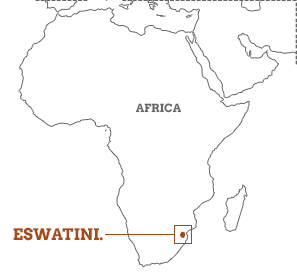Eswatini (Swaziland) travel guide
They say good things come in small packages – Eswatini is proof. At no more than 200km north to south and 130km east to west, it’s one of the tiniest countries in Africa. Culture, wildlife, history and beautiful scenery are packed into one small, very accessible package, making it the ideal destination for anyone new to the continent. With 17 protected areas, it’s home to incredible wildlife, while hiking and biking trails, zip lines and canopy adventures provide adrenaline junkies with their fix, too (in case encountering a black rhino in a bad mood doesn’t do it!).


Eswatini is perfect for the first-time visitor to Africa, offering a compact and colourful microcosm of a complex continent.![]()

Eswatini is one of the world’s last absolute monarchies, led by a king who had the power to singlehandedly change the country’s name from Swaziland to Eswatini in 2018, and daily life is informed by tradition but affected by high HIV rates and unemployment. Despite this, Swazi people are famously hospitable and proud of their culture. Many travelers tag on Eswatini to a tour through neighbouring South Africa, but as our Eswatini travel guide reveals, it’s a glorious destination in its own right.
Eswatini is...
a pocket-sized place with lots of heart and soul.
Eswatini isn't...
all about going on safari. Rich culture and warm people complement the wildlife.
Eswatini (Swaziland) map & highlights
Most visitors to Eswatini arrive via South Africa. You can fly from Johannesburg in 45 minutes, or drive here, reaching the capital Mbabane in a few hours. It’s an easy drive in from Kruger or Durban, too, and you can also reach neighbouring Mozambique, which has excellent beaches, or the St Lucia wetlands on the South African coast. Roads connect the key highlights and since Eswatini is roughly the size of Wales, everything’s in easy reach. The key route between Mbabane and Manzini is much-used, but on less popular roads expect to bump over pot holes, pass ramshackle settlements and negotiate wandering livestock.
1.
Hlane Royal National Park
2. Malolotja Nature Reserve
3. Mkhaya Game Reserve
4. Mlilwane Wildlife Sanctuary
5. Nsangwini Rock Shelter
6. Shewula Mountain Camp
2. Malolotja Nature Reserve
3. Mkhaya Game Reserve
4. Mlilwane Wildlife Sanctuary
5. Nsangwini Rock Shelter
6. Shewula Mountain Camp
Hlane Royal National Park
1. Hlane Royal National Park
This is Eswatini’s largest park – 220km² of beautiful African bushveld dominated by hardwood trees. Some say it’s like Kruger was 30 years ago – basic, really quiet and absolutely lovely. It’s home to fantastic wildlife, including lions, elephants and rhino, but also rich birdlife, with the highest density of nesting white-backed vultures in Africa. Bush walk with a local ranger to get close to the creatures.
Malolotja Nature Reserve
2. Malolotja Nature Reserve
This impressive Highveld conservation area boasts diverse habitats, from scrublands to sub-tropical forests and lush mountain wilderness. With its wonderful views, the 95m-high Malolotja Waterfall, abundant wildflowers in spring and 200km of hiking trails, it’s a joy to explore. Try the canopy tour, navigating rock formations and cliff faces in the forest via platforms, slides and suspension bridges.
Mkhaya Game Reserve
3. Mkhaya Game Reserve
Staffed and patrolled entirely by Swazis from neighbouring communities, Mkhaya has arguably Africa’s most effective anti-poaching unit. The reserve is criss-crossed with dry riverbeds and dotted with waterholes, and offers some of the best black and white rhino viewing in Africa, on foot or by open vehicle. Other giants may swing into view, too, from elephants and hippos, to giraffes and buffalo.
Mlilwane Wildlife Sanctuary
4. Mlilwane Wildlife Sanctuary
This is Eswatini’s most accessible and frequently visited reserve: a beautiful, secluded sanctuary situated in the Ezulwini Valley. Nothing too predatory lives here (although there are hippos) so walking, cycling and even horse riding are possible – unheard of in most reserves – bringing you close to herds of relaxed animals. Guides can also point out mountains streams that are safe to bathe in.
Nsangwini Rock Shelter
5. Nsangwini Rock Shelter
Some 4,000 years ago, the San people used this Highveld area for spiritual rituals and they recorded events, visions and dreams in etchings on the rocks. These images are still visible today and members of the local community, who manage the site, offer informative interpretations of them. Check out nearby Maguga Dam, too, a vast structure across the Komati River, completed in 2001.
Shewula Mountain Camp
6. Shewula Mountain Camp
One of the most successful community tourism projects in Southern Africa, Shewula Mountain Camp was built on land set aside for conservation and is owned and run by local people. Learn about traditional Swazi life from its friendly residents, who live in thatched houses among fields of maize, cotton and vegetables. Enjoy the incredible view, too, over the Lubumbo Conservancy.
South Africa and Swaziland safari
Lodge safari all encompassing South Africa & Swaziland
From
US $2730
17 days
ex flights
South Africa and Swaziland safari vacation
Search for the Big 5 in South Africa and Swaziland
From
US $1940 to US $2330
10 days
ex flights
Family vacation to South Africa & Swaziland
Kruger, Swaziland and Durban with the family
From
US $2340
13 days
ex flights
Mozambique, Zululand & beach small group safari
Relaxing Beach & Bush safari through South Africa Mozambique
From
US $2395
14 days
ex flights
South Africa, eSwatini and Lesotho vacation
Short tour takes you to one of the world’s best game parks
From
£1799
14 days
ex flights
Kruger, coast and cape vacation in Southern Africa
African wildlife, friendly locals and relaxing beaches
From
US $2959 to US $3590
22 days
ex flights
Travel Team
If you'd like to chat about Swaziland or need help finding a vacation to suit you we're very happy to help.
1-866-821-6866
Call toll free
Calling from outside the USA















